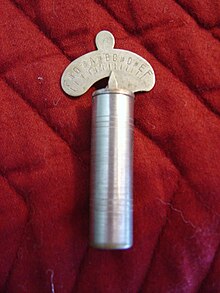Pitch pipe

A pitch pipe is a small device used to provide a pitch reference for musicians. Although it may be described as a musical instrument, it is not typically used to play music as such. Technically, it is a tuning harmonica; however, it lacks many characteristics of harmonicas.
Origins

The earliest pitch pipes were instruments similar to the recorder, but rather than finger holes, they had a plunger like a slide whistle's (also known as a swanee whistle) making it essentially a type of Slide Whistle. The pipe was generally made of wood with a square bore, and the plunger was leather-coated. On this plunger are marked the notes of either the chromatic scale or the diatonic scale, and by setting it to the correct position, the indicated note will be produced when the instrument is blown. Pitch pipes come in all sorts of shapes and sizes.
Pitch pipes of this sort were most often used in the 18th and 19th centuries in churches which had no organ to give the opening note of a hymn. They are now quite rare, and hardly ever used for what they were intended for, but may still be used as an alternative to a tuning fork. They are also useful for establishing what pitch standard was being used at a particular place and time.
Modern pitch pipes
Although few look like a pipe, the pitch pipe name is still applied to any device used as a pitch reference. The most common type is a circular
Usage
Some pitch pipes are intended for tuning string instruments, and only provide reeds for notes appropriate to a particular instrument. Chromatic pitch pipes are favored by a cappella singers and timpanists. Chromatic pipes most often provide thirteen pitches, each a half step above the previous. By providing all of the notes of a single octave, a singer can start in any key called for in Western music. Different pipes are available for bass and treble voices due to variations in vocal range. Most male and female performers prefer to use F-F pipes and C-C pipes, respectively.[1][unreliable source] However, it is particularly notable that the Men's pipe in F is pitched higher than the Women's C pipe. Pipes in other keys are available, but are much more rare.
The singers' normal use of the pipe is to play the initial
In
Problems
The brass reeds in common pitchpipes are subject to
See also
References
- ^ "Performance Plus CP-C Vocal Chromatic Pitch Pipe Key of C to C with Carrying Bag". Musician Madness. Retrieved 2018-04-27.
This article includes a improve this article by introducing more precise citations. (March 2016) ) |
Further reading
- Anthony Baines, "The Oxford Companion to Musical Instruments" (1992) Page 267, ISBN 0-19-311334-1
External links
- An "online pitch pipe" (recordings of each of the pitches on a free-reed instrument)
- Mechanical Engineering Projects (Pip pitch record)
- A zipped downloadable version of the "online pitch pipe" (recordings of each of the pitches on a free-reed instrument) for your cell phone.
- Five Types of Metal Pitch Pipes, whistle museum (Including free down loads samples)
